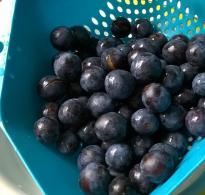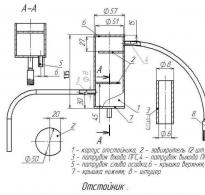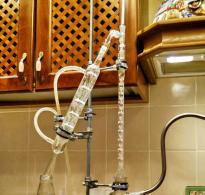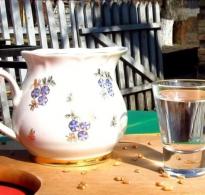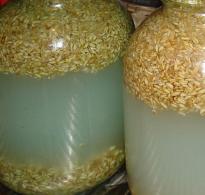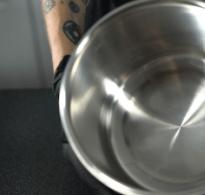The difference between acetic acid and essence. Difference between vinegar and acetic acid
Some ordinary people believe that there is no difference between vinegar and the acid of the same name. But this opinion is wrong, and the two products cannot be called interchangeable. Consider what features are present in each case and how vinegar differs from acetic acid.
Acetic acid is a corrosive substance with the formula CH 3 COOH.
Comparison
In each case, the object of attention is a colorless, sometimes slightly colored liquid of natural or synthetic origin. And the difference between vinegar and acetic acid lies in the content of the main substance.
The basic component is exactly acetic acid... It can be absolute, waterless. You will not find such a product on free sale. It is intended for laboratory use only. The acid is handled with extreme caution, since even its vapors strongly irritate the mucous membrane. respiratory tract... And ingestion of a very small dose can cause fatal burns.
However, there is a product in this category on the shelves, which is an acid diluted 20-30% with water. It is called " vinegar essence". The concentration of the main substance in such a solution is also very high, therefore, one must be careful here too. The essence is most often purchased in order to further add water to it in the right amount and get nothing more than vinegar. This final composition is less pronounced sour taste.
So, vinegar is the solution with the smallest concentration of the base substance. It can be as high as 15%. But the most widely used composition is in which the proportion food acid much less - 9 or 6%. Already ready product can be bought without any problems in a regular store.
Considering what is the difference between vinegar and acetic acid, it is worth mentioning the benefits of products of this category. The acidic composition is in demand as an important ingredient in everyday cooking and for preservation. But vinegar is used not only for food purposes.
With the help of it, for example, you can remove rust and scale from objects, as well as remove blockages, using in addition soda and boiling water. The vinegar added to the flower vase prolongs the life of the bouquet. This composition will remove the stale smell from the refrigerator or cabinet, it is only necessary to wipe the surface with a damp cloth. Vinegar finds its use in many other ways.
Vinegar essence, or acetic acid, as some manufacturers call it, is far from vinegar. Although the latter can be prepared from this substance easily. Essence is a product obtained chemically - from the distillation of wood raw materials or as a result of the fermentation of alcohol. The substance has slightly different characteristics than the usual for many table 9% and weaker vinegar.
Acetic acid is a product that does not have a shelf life, while natural vinegar or a solution of a lower concentration is recommended to be used for three years. You can buy it in containers of various sizes, but most often the acid is sold in bottles and looks like in the photo.
Acetic essence is used in book printing and for oxidation reactions. The substance can be called a solvent. For the first time, the substance was obtained by the Arab alchemist Geber, who lived in the 8th century AD. From the fermented wine, he expelled vinegar concentrate, which was originally used to process copper.
Composition and chemical properties of the food additive
Composition and Chemical properties food additives are inextricably linked. Acetic essence is an aqueous solution derived from "glacial" 100% acetic acid. Acetic acid is obtained by distilling fermented wine or fruit juice. The resulting substance is diluted with water to a concentration of 70 or 80 percent of the feedstock. In this form, the essence goes on sale. At the same time, many manufacturers write on their packages not "vinegar essence", but "acetic acid" of a certain strength. The concentration of the substance can also be as high as 30%, therefore, carefully read the label before using this corrosive product. On the latter, there are often recommendations on how to dilute the substance to the desired strength.
Acetic acid looks exactly like ordinary table vinegar: a clear liquid without sediment, flakes and other inclusions. The substance has a pronounced aroma, similar to table vinegar, but its vapors are harsher. This preservative is a raw material for synthesizing:
- fatty acids;
- sterols;
- steroids;
- terpenes.
The substance does not contain proteins and fats, but its calorie content is about 12 kilocalories per hundred milliliters. As with any acid, alkali is the neutralizer of this caustic aqueous solution.

The use of vinegar essence and its beneficial properties
V pure form vinegar essence is an inedible substance, and it is used mostly for technical purposes. Also, the product is used in canning and medicine. You can buy an acetic acid preparation in pharmacies.
Due to the fact that the substance is toxic, precautions should be taken when using it. It should also be mentioned that this substance, reacting with household soap (or any alkali), as well as gasoline, can produce an undesirable reaction.
In cooking
The substance is used not only in industrial canning, but also in home process preparation of vegetables, meat, fish and berries. Most often, the essence is used to prepare table vinegar and all kinds of marinades. As many housewives note, cucumbers marinated with essence are crisper and more beautiful than rolled with ordinary table vinegar.
In undiluted form, the substance is used in the preparation of fish according to the recipes of he, as well as for soaking meat delicacies.
The substance should not be boiled. A certain amount of this acidic liquid is poured directly into cans of blanks, and then the lids are immediately rolled up. Most often one liter jar canned vegetables put no more than one teaspoon of 70% essence. The volume of the substance is then five milliliters.
How to dilute the essence to the concentration of the table or more "light" salad vinegar, you will learn from the table. We take ten milliliters of vinegar essence of a given concentration as a basis. The cell at the intersection indicates the amount of net cold water in milliliters and the approximate amount in spoons.
In order to get vinegar of a non-standard concentration from the essence, you should adhere to the following proportions:
The amount of essence in this case is also ten milliliters.
The rules for making vinegar from acid are that:
- vinegar concentrate should be poured into water, and not vice versa;
- the liquid should be cool;
- mixing of the product should take place in a closed container.
In order to prepare a high-quality solution, you should follow the rules for its preparation and be sure to provide proper storage conditions.

At home
The beneficial properties of vinegar essence are noted not only in cooking, but also in everyday life. The substance is used for many business operations. Most often these are:
- descaling a washing machine and dishwasher, as well as a cooler, non-flowing water heater or kettle;
- soaking labels and stickers;
- stain removal of various origins from carpets, clothing and other surfaces;
- disinfection kitchen utensils, refrigerator and furniture;
- elimination of pungent odors on cutting boards and utensils;
- washing plumbing fixtures;
- elimination of blockages in sewers and drains;
- rust removal;
- cooking detergents for glass and other glossy surfaces.
Acetic essence is classified as a solvent. This substance can be used to wash coins, as well as gold and silver jewelry. In addition to all of the above, vinegar essence is added to fix dyes on fabrics. It is not uncommon to find recommendations for the management of household, where experienced housewives it is advised to soak bed linen before first use in water with the addition of vinegar essence. Such a simple action allows you to fix the color of the products. Such a product "works" especially well on coarse calico, cotton and flax.
With the help of the substance, bedbugs and small insects are removed, and also get rid of body lice and their nits. Nice results gives a product in the fight against mold fungi and fleas.
The dosage of the substance and its concentration differ depending on the method of application, so you should definitely study the recipe or advice, and then clearly observe the proportions. You should also remember about the precautions when using the essence.

In medicine and cosmetology
The concentrated substance is used in traditional medicine and pharmacology. On the basis of the essence, medicines are made. V folk medicine and in cosmetology, pure vinegar essence is used to prepare ointments and creams to get rid of:
- warts;
- papillomas;
- corns on the heels (heel spurs);
- nail fungus.
A popular ointment for getting rid of heel spurs is prepared on the basis of glycerin or butter... also in medicinal composition added egg... Another acetic acid-based ointment is called "Ogonyok". It is prepared using sewing needles. This substance is said to help with joint pain.
The acid diluted with water is used for rinsing hair, wrapping at a temperature (fever) and other cosmetic or medical procedures, such as peeling. There are recipes for solutions that are used for douching for candidiasis (thrush). With the help of substances containing vinegar concentrate in the composition, diseases of the outer ear can be cured.
Herbs insist on vinegar essence. Substances obtained in this way are used to rub the affected areas of the body and apply compresses. Many people who have tried on themselves therapeutic effect tinctures based on acetic acid, note the effectiveness of these drugs. The most commonly used are similar folk remedies based on acetic acid for the treatment of psoriasis and gout.

Precautions and storage rules
When using vinegar essence, precautions and storage rules should be observed. The main provisions are as follows:
- Sign the bottle with the product. It is better if the factory sticker remains on it. Do not pour acid into other containers!
- Make sure that the vessel is away from heat sources and out of the reach of children. Pets can also be in danger, but for the most part they are deterred by the strong smell of the substance.
- Do not use the product undiluted. Even a drop of the substance can cause burns to the mucous membrane and respiratory tract!
- In order to avoid burns on the hands and body, all work with the use of vinegar essence should be carried out in rubber gloves, and also make sure that no one is distracted at this moment.
- Using a concentrated product for the preparation of ointments, canned food or tinctures, pre-measure the right amount substance, and take the excess to the place of permanent storage.
- Make sure that the container with the substance is tightly closed, because the essences vapors are also very toxic.
If the substance gets on the skin or eyes, then, without wasting time, be sure to rinse the surface first big amount water, and then a weak solution of alkali (for example, baking soda). An excellent antidote for acetic acid vapor poisoning is cow's milk. But, even having taken emergency measures to eliminate the consequences, you should immediately seek qualified medical help.

Contraindications and harm
In the section on the assessment of contraindications and harm from the use of vinegar essence, the first thing I want to note is that only two tablespoons of the substance with a strength of over thirty percent are lethal dose for a person. The way the acid enters the body does not matter.
You shouldn't use this food additive and prepare vinegar from it for people suffering from:
- epilepsy;
- asthma;
- mental disorders such as schizophrenia;
- diseases of the cardiovascular system;
- impaired coordination of movements.
Care should be taken to use the substance for pregnant women, because its vapors are toxic. Their effect on fetal development is not yet fully understood, but is it worth the risk? People who have had hepatitis A (Botkin's disease) or suffer from a chronic form of this disease, as well as patients with diabetes and other disorders of the pancreas, are at risk from the use of ointments and other traditional medicine.
It should also be remembered that oral solutions prepared using vinegar essence (they are often recommended by traditional healers to combat overweight or digestive problems) harm the tooth enamel.
In conclusion of the article on vinegar essence, I would like to note the following: before using this concentrated preservative in cooking or everyday life, be sure to weigh the pros and cons, and also be sure to take precautions.

Vinegar uses great amount people around the world. It is an indispensable component for preservation, which possesses unique properties... But still, few people know that vinegar and acetic acid are not the same thing. Because of this, various accidents very often occur, in which even fatal outcomes are possible. Therefore, let's see how vinegar differs from acetic acid.
Table vinegar is an aqueous solution of acetic acid (CH3COOH), which has a concentration of 6 to 9%, or another, depending on requirements. Also, you can always create the desired concentration for yourself, you just need to know how to dilute acetic acid in water, or rather in what proportions. Acetic acid, or acetic essence, is the trade name vinegar solution, but its concentration is 80%. In some countries, this acid has long been discontinued. There is also glacial acetic acid (anhydrous), which has a concentration of 99-100%. It is possible to buy such an acid only for research in special scientific laboratories. There is also acetic anhydride - a more dehydrated option. But the production of this substance is very closely monitored, since it is used for narcotic purposes for the manufacture of acylated opium at home. Of course, glacial acetic acid is also used for such purposes, but more rarely. It should be noted that acetic anhydride and acid are used in the synthesis of aspirin.
From what we have read, we can conclude that vinegar and acetic acid are practically the same thing, but with different concentrations of vinegar in water. Thus, it is important to know how you can dilute the vinegar essence or acid, since this will greatly help in the household, namely during the preparation of canning. Dilution is very simple - acetic acid is simply mixed with a certain amount of water, and everything is a very simple process and can be done at home.
Before considering the question of where and for what the vinegar essence is used, we consider it necessary to define this material.
Acetic acid, vinegar essence, vinegar - what's the difference?
All these products differ in the concentration of the main substance. So, acid is, in fact, almost 100% ice concentrate, essence is 70-80% aqueous solution of this acid, and table vinegar, well known to everyone and actively used in household purposes Is a 3-15% liquid substance with strong acidic characteristics.
That is vinegar essence name a chemical product, mainly an 80% solution of acetic food grade acid, obtained in industry during the fermentation of acetic acid liquid substances, which include alcohols.
The use of vinegar essence
Various concentrations of acetic acid (E260), including essence, are widely used in various industrial sectors, mainly in the food industry. In addition, this material is actively used in everyday life when cooking. It is used in making marinades and in canning. With his help various dishes add pungency and sour taste. Also, if necessary, a less concentrated vinegar is created from it in the absence of one at hand.
Acetic acid, its concentrates and other industries are used to achieve different goals. Medicines are made from it, for example, to lower the acidity of gastric juice and, thus, to promote digestion. In some cases, it is replaced by ammonia when removing a person from fainting, due to a sharp irritating smell. As for the use of this substance for weight loss, this is a myth, which, by the way, can lead to major health problems, up to and including death.
It is also used in printing books and dyeing, when creating aromatic substances, as a solvent (production of cellulose acetate and acetone), antiseptic, descaler. The role of acetic acid in home cleaning is worth mentioning here. Mirrors, windows, pots and other stainless steel dishes, refrigerators and other Appliances, tiles, washable wallpaper, laminate flooring, kitchen countertops, plumbing surfaces - all this and much more can be easily and effectively cleaned using a suitable concentration of ethanic (aka acetic) acid.
And, of course, this is an excellent laboratory and industrial reaction medium used when it is necessary to oxidize all sorts of organic substances.
Vinegar essence and safety precautions
When dealing with this product, it must be remembered that it is toxic and inedible. If the recommendations for use are not followed, it can lead to severe intoxication, poisoning and burns. Therefore, it is important to follow certain rules. They are simple, but very important:
- it must be stored in a place where children and pets do not have access;
- the container must be signed;
- it is prohibited to eat undiluted;
- it is important to be careful and avoid contact with the skin and eyes to prevent severe burns;
- if contact with the skin cannot be avoided, rinse the affected area with a large volume of running water, then treat it with a weak solution of sodium bicarbonate (also known as baking soda);
- in case of contact with eyes, rinse immediately with water, but this will not be enough, seek medical attention without delay;
- Please note that vapors are also dangerous, so you should not inhale them.
Now you know how to use vinegar essence correctly, what it is needed for and what to do in case of injury by this substance. If you have any questions, please contact us - we will be happy to help you find the answers!
Description
Acetic acid in a concentration of almost 100% is called glacial, an aqueous solution of this acid (70-80%) is called acetic essence, and a strongly acidic liquid with a concentration of 3-15% is known to everyone regular vinegar... It should be noted that acetic acid in various concentrations is actively used in industry, in particular in food (E260), as well as for homemade food, for example, for canning.
If we follow the official data, then an 80% aqueous solution of food-grade acetic acid, which is obtained industrially during the fermentation of acetic acid alcohol-containing liquids, is commonly called acetic essence. As a rule, the vinegar essence is further used to obtain less concentrated table vinegar, as well as for the preparation of marinades and canning.
Very often, according to one or another recipe, the usual 9% vinegar is required, and only the essence is available, or vice versa. This turn of the matter puzzles many housewives, but in reality, both of these products are interchangeable. And the main thing that you need is to know the exact proportions.
For example, to get ordinary table vinegar from the essence of 70%, you need to take 1 tablespoon of the essence
- - for 3% vinegar - 20 tbsp. water;
- - for 6% - 11 tbsp. water;
- - for 9% - 7 tbsp. water.
For the reverse process, you will have to reduce the amount of water, but take more ordinary table vinegar. That is, to get 1 tablespoon of vinegar essence at a concentration of 70%, you need to take:
- - 7 tbsp. water - 8 tbsp. 9% vinegar;
- - 11 tbsp. water - 12 tbsp. 6%;
- - for 20 tbsp. water - 21 tbsp. 3%.
Acetic acid preparations
Glacial acetic acid - Acetum aceticum glaciale - contains 96% CH3COOH, used as a cauterizing agent for calluses and warts.
Acetic essence, diluted acetic acid (30–80%) - Acidum aceticum dilutum - is used as an itching and keratolytic agent in various ointments. 30% vinegar essence, along with formalin, is used for fungal diseases and mycosis of the feet as a means for disinfecting shoes, treating insoles in order to prevent self-infection: the inner surface and insoles of shoes are wiped with 30% vinegar essence applied to a cotton swab and placed in a tightly tied plastic bag on 2 hours, after that the shoes are ventilated until the smell disappears.
Table vinegar (9%) - Acetum - diluted (2–5 tablespoons per glass of water) is used as a soothing agent for itching, urticaria, insect bites.
Undiluted vinegar is used for head lice to remove head lice nits. In folk medicine, a decoction of calamus rhizomes used to treat baldness and hair loss, a decoction of nettle leaves, used to treat seborrheic alopecia, is prepared on vinegar.
Table vinegar mixed with boric acid and cologne or alcohol (boric lotion) is used for excessive sweating (hyperhidrosis).
Aromatic vinegar- Acetum aromaticum - greens of tarragon, celery or dill (50 g) per 0.5 l of 9% table vinegar, you can also add a leaf black currant and lime blossom (50 g). Insist for 2 weeks, filter, and store in a tightly sealed dark glass bottle. Fragrant vinegar is used for rubbing the skin, tightens the enlarged pores of the face, has an astringent and refreshing effect, and is used for hyperhidrosis (sweating).
Apple cider vinegar is used as a disinfectant and soothing agent for daily rubbing of the affected skin with pyoderma (impetigo).
Acetic acid poisoning
Acetic acid acts more superficially than inorganic acids. Otherwise, its action in case of poisoning is similar to the action of inorganic acids (nitric, sulfuric, hydrochloric).
Vapors of acetic acid, when poisoned, enter the lungs and are released by them, which leads to severe pneumonia.
Characterized by hemolysis and associated hemoglobinuria.
A lethal dose is 12-15 ml of anhydrous acid or 20-40 ml of vinegar essence (200-300 ml of vinegar).
Acetic acid is easily detected at autopsy by specific smell; also characterized by necrosis, hemorrhages in the liver, hemolysis, necrotic nephrosis, etc.
Properties
Acetic acid (CH3COOH, acidum aceticum) is a natural limiting monocarboxylic organic acid, is a colorless transparent liquid with a specific odor.
Acetic acid is the starting material for the biosynthesis of fatty acids, steroids, sterols, and terpenes in the body. Participates in the formation of acetyl coenzyme A.
The benefits of vinegar essence
Vinegar essence cannot be counted useful product, but without it it is impossible to implement some culinary processes... In moderate quantities, vinegar essence has a stimulating effect on metabolic processes in the body. Vinegar helps the body fight various infections, removes putrefactive formations from the body.
How to work with essence
Safety rules are simple:
- Keep essence out of the reach of children and pets.
- The container must always be signed.
- In no case should you eat undiluted essence - it is deadly.
- Acetic acid causes severe burns to the mucous membranes, so you need to work with it very carefully, avoiding contact with the skin and eyes.
- In case of contact with skin, rinse with plenty of running water, then with a weak solution of baking soda.
- In case of contact with eyes, rinse with plenty of running water and seek medical advice immediately.
- The vapors are also dangerous and can cause burns to the respiratory tract, so try not to inhale them.
Caloric content of Vinegar essence is 11.3 kcal.
Energy value of the product Vinegar essence (The ratio of proteins, fats, carbohydrates):
Proteins: 0 g. (~ 0 kcal)
Fat: 0 g. (~ 0 kcal)
Carbohydrates: 3 g. (~ 12 kcal)
Energy ratio (b | f | y): 0% | 0% | 106%
Harm and contraindications
By itself, vinegar essence is a toxic inedible substance used in everyday life. It is this liquid that often becomes the cause of intoxication and serious poisoning. Indeed, in the absence of timely assistance, only 30-50 ml of 80% vinegar essence can become a lethal dose.
If by chance the vinegar essence gets inside the body, it can lead to severe burns of the mucous membrane of the mouth, pharynx, esophagus or stomach. In addition, even a single intake of this liquid can lead to diseases such as hemolysis, hemoglobinuria, acidosis, as well as blood clotting disorders, which is accompanied by severe bleeding in the area gastrointestinal tract... To avoid these unpleasant consequences, it is necessary to apply the essence of vinegar and any other only in diluted form and in small quantities, and also store it as far away from children as possible.

